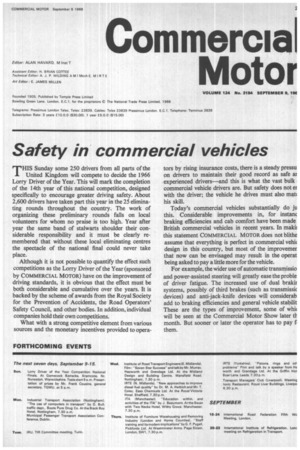Safety in commercial vehicles
Page 29

If you've noticed an error in this article please click here to report it so we can fix it.
THIS Sunday some 250 drivers from all parts of the United Kingdom will compete to decide the 1966 Lorry Driver of the Year. This will mark the completion of the 14th year of this national competition, designed specifically to encourage greater driving safety. About 2,600 drivers have taken part this year in the 25 eliminating rounds throughout the country. The work of organizing these preliminary rounds falls on local volunteers for whom no praise is too high. Year after year the same band of stalwarts shoulder their considerable responsibility and it must be clearly remembered that without these local eliminating centres the spectacle of the national final could never take place.
Although it is not possible to quantify the effect such competitions as the Lorry Driver of the Year (sponsored by COMMERCIAL MOTOR) have on the improvement of driving standards, it is obvious that the effect must be both considerable and cumulative over the years. It is backed by the scheme of awards from the Royal Society for the Prevention of Accidents, the Road Operators' Safety Council, and other bodies. In addition, individual companies hold their own competitions.
What with a strong competitive element from various sources and the monetary incentives provided to opera tors by rising insurance costs, there is a steady pressu on drivers to maintain their good record as safe at experienced drivers—and this is what the vast bulk commercial vehicle drivers are. But safety does not er with the driver; the vehicle he drives must also mat( his skill.
Today's commercial vehicles substantially do ju this. Considerable improvements in, for instanc braking efficiencies and cab comfort have been made British commercial vehicles in recent years. In makii this statement COMMERCIAL MOTOR does not blithe assume that everything is perfect in commercial vehi( design in this country, but most of the improvemer that now can be envisaged may result in the operat being asked to pay a little more for the vehicle.
For example, the wider use of automatic transmissio and power-assisted steering will greatly ease the proble of driver fatigue. The increased use of dual brakit systems, possibly of third brakes (such as transmissic devices) and anti-jack-knife devices will considerab add to braking efficiencies and general vehicle stabilit These are the types of improvement, some of whi( will be seen at the Commercial Motor Show later tF month. But sooner or later the operator has to pay f them.
































































































































